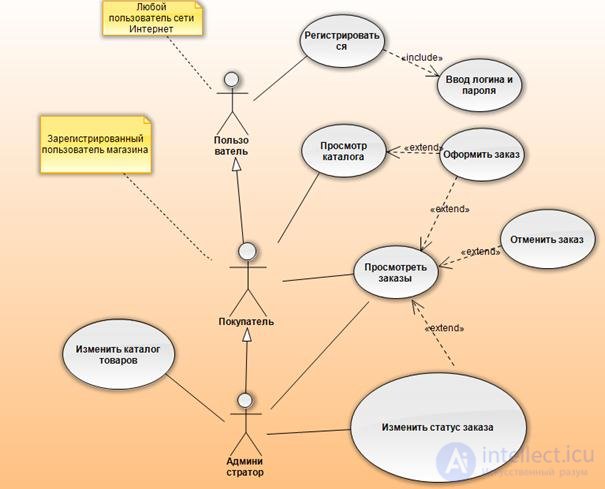Lecture
Identifying the actors. The development of case diagrams should begin with the definition of the cast list.
The following questions can be used to identify actors:
- who is interested in a specific system requirement;
- what role will the system play in the organization;
- who will benefit from using the system;
- who will supply the system with information, use information and receive information from the system;
- who will support and maintain the system;
- whether the system uses external resources;
- Does any participant in the system in several roles;
- whether the various participants act in the same role;
- will the new system interact with the old one?
Identify precedents. After creating the list of actors, it is necessary to consider how each actor is going to use the system, and new actors may show up during the identification of the cases. To find a precedent, it is necessary to find answers to the questions: “How does each of the actors use the system?” And “What does the system do for each actor?”.
In order to highlight the use cases for the system, you can use the following questions:
- what are the tasks of each actor;
- whether the actor will create, store, modify, delete or receive information from the system;
- what precedent will create, store, change, delete or receive this information;
- whether the actor should inform the system about sudden changes in the external environment;
- Should the actor be informed about changes in the state of the system?
Example use case diagram. Let us consider an example of developing a use case diagram for an “online store” system (Fig. 5.14). The online store should allow you to make purchases delivered to your home. Customers of this store using a browser program have access to the catalog of goods sold. For the convenience of customers, the catalog provides for a product search system in which all products are divided into sections and complete information is provided about each product (name, weight, price, image, date of manufacture, and shelf life). When customers select goods, a virtual shopping cart is supported. Any item name can be added to the cart or withdrawn from it at any time at the request of the buyer, followed by recalculation of the total purchase price. The current contents of the cart are constantly displayed to the client. At the end of the selection of goods made an order and registration of the buyer.

Fig. 5.14. Chart of precedents of the "online store"
In fig. 5.14 as the actors of the simulated system, any user, customer (registered user) and administrator are highlighted. Since the administrator can do everything the buyer and the user do, a generalization relationship is shown between these actors. However, neither the buyer nor the user can change the product catalog and the status of orders, so the association relations in the diagram are shown only between the actor "Administrator" and the precedents "Change product catalog" and "Change order status".
Comments
To leave a comment
System modeling
Terms: System modeling